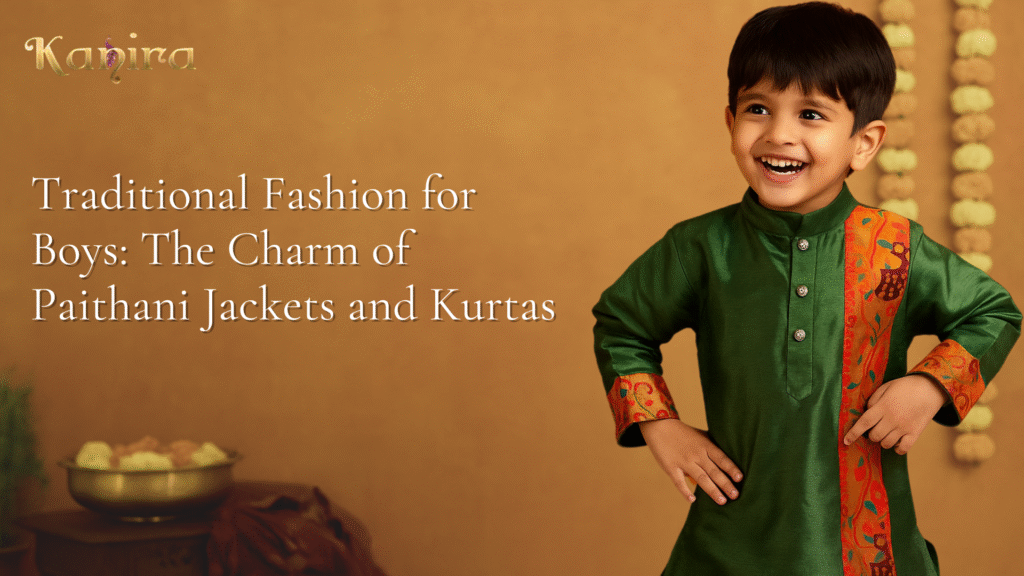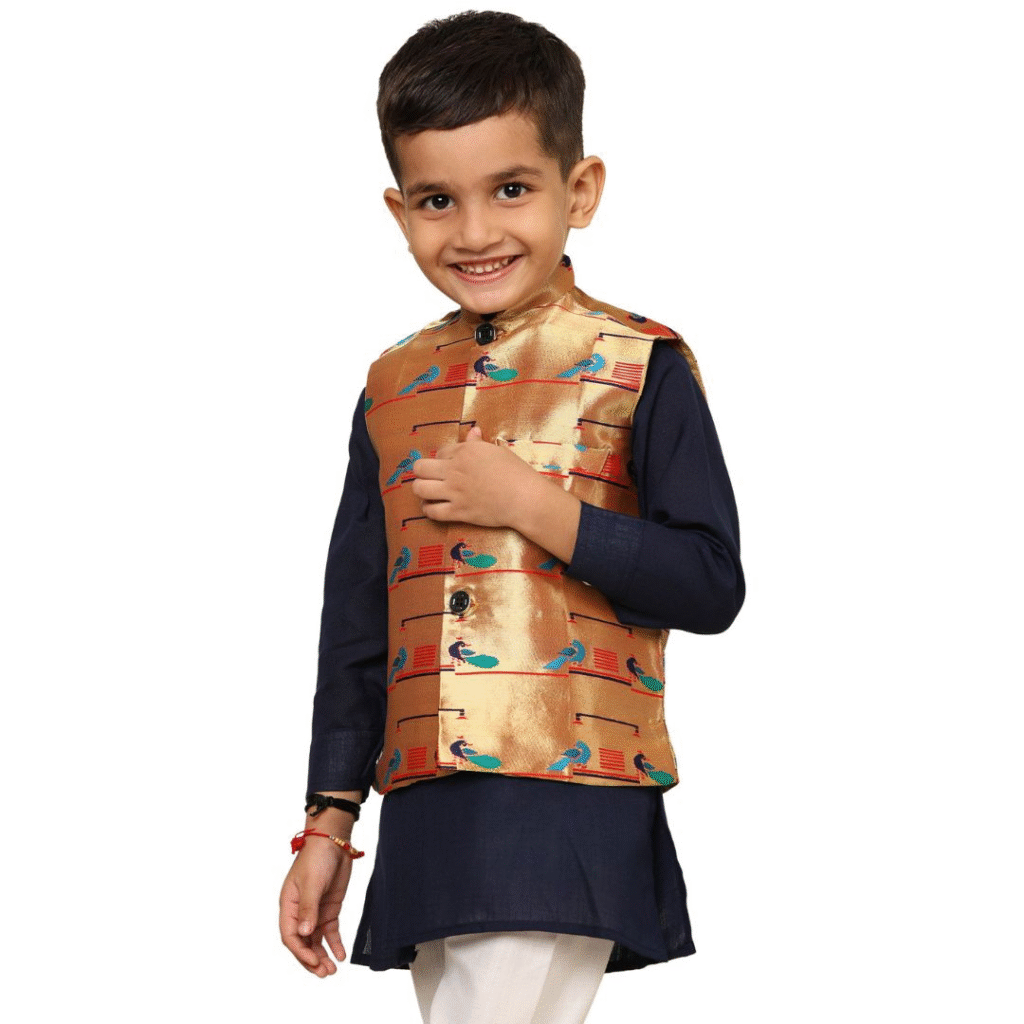


In an age where kids’ fashion is becoming increasingly westernized, Traditional Fashion for Boys offers a meaningful and elegant alternative that connects children to their roots. Paithani jackets and kurtas bring the grandeur of Maharashtrian handloom into mini silhouettes that are festive, functional, and culturally rich. Whether it’s Diwali, a wedding, or a school cultural program, these outfits help children embrace tradition without compromising on comfort.
What makes traditional fashion for boys truly timeless is its ability to combine age-old artistry with child-friendly designs. From vivid silk textures to soft linings and accessible fittings, these outfits are crafted to honor heritage while ensuring kids enjoy wearing them. They are more than just garments — they are expressions of identity and pride, right from an early age.
Paithani, originally reserved for queens and royals of Maharashtra, is now a fabric that also celebrates childhood. The motifs like peacocks, parrots, and lotus vines woven with zari are deeply symbolic — and when adapted into traditional fashion for boys, they become a playful yet elegant reflection of cultural richness.
Unlike adult Paithani sarees or shawls, Kanira’s kids’ collection uses lighter fabrics and shorter weaving lengths while preserving the essence of the design. The result is a collection of Paithani jackets and kurtas that look regal yet feel comfortable enough for a child’s energetic day.
Boys’ ethnicwear from Kanira is thoughtfully made with breathable materials, non-irritating linings, and easy closures like side zippers or elastic waists. This ensures that the garments don’t just look good but feel good too — especially during long hours of wear at ceremonies or functions.

This festive-ready set features a deep navy kurta with rich orange Paithani borders, complemented by a soft silk dhoti. The subtle zari work makes it perfect for traditional occasions like Ganpati celebrations or naming ceremonies.
Style Tip: Pair with traditional Kolhapuri sandals and a small tilak on the forehead for a complete ethnic look.

A soothing yet festive option, this set features a matching mehndi green tone in both the kurta and dhoti with Paithani detailing on the sleeves and hem. Ideal for outdoor weddings and pujas, this outfit blends grace with vibrancy.
Style Tip: Accessorize with a beaded necklace or brooch for extra charm.

A statement layering piece, this double peacock motif jacket can instantly transform a plain kurta set into a showstopper ensemble. Made with lightweight Paithani silk and soft lining, it’s perfect for winter weddings or evening functions.
Style Tip: Layer over a beige or white kurta-pajama set to let the motifs shine.
Pair a Paithani kurta with cotton pajamas or jeans for a semi-traditional, school-friendly look. Add a small Nehru topi for extra flair.
Opt for a full dhoti-kurta set with a contrast Paithani jacket. Choose bold colors like navy, red, or emerald for photo-perfect festive styling.
Coordinate with a sister’s Paithani lehenga or mother’s saree for a heartwarming family match. Use similar color themes or motif designs.
Traditional fashion for boys is a powerful way to pass on values, history, and pride. When children wear ethnic clothing, they not only look charming but also feel included in family traditions and rituals. It creates a sensory connection to culture — through color, fabric, and design — and helps them carry these traditions forward.
Don’t miss our earlier post:
Paithani Kurta for Boys – A Festive Style Essential
From playful kurtas to princely jackets, explore Kanira’s full range of traditional outfits for boys and dress your little one in pieces that celebrate culture with comfort.
Explore All Boys’ Paithani Outfits
Q1: What age groups are these outfits designed for?
Kanira’s collection covers boys aged 1 to 12 years, with inclusive sizing to ensure comfort for toddlers and pre-teens alike.
Q2: Are the kurtas and jackets lined for comfort?
Yes, all items include breathable inner lining to prevent skin irritation and ensure all-day wearability.
Q3: Can I buy coordinated outfits for siblings?
Absolutely! Many motifs and colors are available in girls’ lehengas and women’s jackets too, perfect for family twinning.
Q4: Are the fabrics skin-friendly for kids?
Yes. The materials are specially selected for softness and breathability, ideal for young, sensitive skin.
Q5: How do I care for these outfits?
Gentle hand wash or dry cleaning is recommended, especially for pieces with zari or Paithani weaving.
Dressing boys in Paithani jackets and kurtas is not just about appearances — it’s about introducing them to tradition, dignity, and pride. Each motif tells a story; each thread holds history. By choosing traditional fashion for boys, you’re giving your child more than just a festive look — you’re gifting them a cultural foundation. These clothes make memories — of first festivals, family rituals, and proud photographs — all wrapped in timeless beauty.